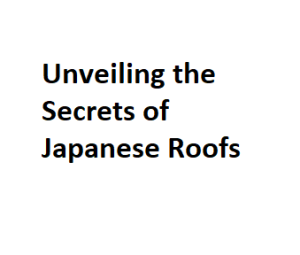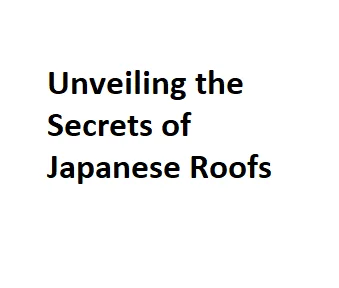When one thinks of Japan, images of cherry blossoms, ancient temples, and traditional architecture often come to mind. Among the many elements that contribute to the charm of Japanese buildings, roofs play a significant role. Explore the captivating world of Japanese roofs, where distinctive designs and materials not only please the eye but also embody the country’s rich cultural and historical legacy. Uncover the centuries-old materials that contribute to these unique architectural marvels.
Thatch Roofs:
Embracing Nature’s Bounty Thatch roofs, known as “kayabuki,” are one of the oldest and most traditional roofing styles in Japan. These roofs are constructed using layers of dry grass, straw, or reeds. Thatch not only provides excellent insulation but also allows the building to harmonize with its natural surroundings. While less common in modern urban architecture, you can still find thatched roofs in rural areas and historical villages.
Ceramic Tiles:
Timeless Elegance Ceramic tiles, or “kawara,” have been a staple in Japanese roofing for centuries. These tiles are typically made from clay and come in various shapes and sizes. The interlocking design of the tiles provides a durable and weather-resistant covering for the roof. The distinctive curved eaves, often seen in traditional Japanese architecture, are a result of the use of these tiles.
Bamboo and Wood:
Blending Tradition with Sustainability: For centuries, wood has been a pivotal construction material in Japan, extending its influence to roofing. The incorporation of wooden shingles and bamboo thatch results in visually stunning roofs that harmonize seamlessly with the traditional design of Japanese houses. This combination not only highlights the aesthetic appeal but also showcases the sustainable practices inherent in traditional Japanese architecture.
Modern Materials:
Adapting to Contemporary Needs: With the advent of modern construction methods and the need for more durable and fire-resistant materials, Japanese roofs have evolved. Today, you can find roofs made from materials such as metal, asphalt, and synthetic tiles. While these materials may lack the traditional charm of thatch or ceramic tiles, they offer practical advantages in terms of longevity and maintenance.
The Cultural Significance:
Beyond Construction: Japanese roofs aren’t merely functional components of a building—they carry cultural significance. The distinct shapes, styles, and materials used in Japanese roofing often reflect regional traditions, social status, and even religious beliefs. For example, the irimoya-zukuri style, characterized by a hipped roof, is commonly associated with shrines and temples.
Maintenance and Preservation:
A Delicate Balance: Preserving traditional Japanese roofs requires careful maintenance and attention to detail. Thatch roofs, for instance, need periodic re-thatching to maintain their effectiveness and aesthetic appeal. Ceramic tiles may require occasional replacement, but their durability often reduces the frequency of maintenance. Traditional craftsmanship is essential in ensuring that these roofs continue to withstand the test of time.
Regional Variations:
A Tapestry of Styles: Japan’s diverse geography has spawned distinct regional architectural styles, each boasting unique roofing traditions. The steep, thatched roofs of Gassho-zukuri houses in Shirakawa-go, for example, contrast with the flat, ceramic-tiled roofs prevalent in historic merchant districts like Kyoto. Exploring these regional variations provides a deeper understanding of Japan’s cultural diversity.
Influence on Modern Architecture:
Balancing Tradition and Innovation: In Japan, architects draw on traditional roofing styles despite the modern focus on efficiency and cost-effectiveness. Contemporary buildings frequently incorporate traditional elements like ceramic tiles or wooden accents, achieving a harmonious blend of past and present. This fusion highlights the adaptability of Japanese architecture.
Environmental Considerations:
Embracing Sustainable Practices: With a growing global focus on sustainability, traditional Japanese roofing materials are gaining renewed attention. Thatch, bamboo, and wood, being renewable resources, align with environmentally friendly building practices. The integration of these materials into modern construction not only connects with Japan’s historical roots but also contributes to sustainable architecture on a broader scale.
The Future of Japanese Roofs:
Nurturing Heritage: As Japan continues to modernize, it faces the challenge of balancing progress with the preservation of its cultural heritage. Efforts to protect and restore historic buildings, including their roofs, play a crucial role in maintaining a connection to the past. Initiatives to educate the public about traditional architecture and craftsmanship contribute to the ongoing appreciation of Japanese roofs.
Cultural Symbolism in Roof Design:
Stories in Every Line: Japanese roofs often incorporate symbolic elements that go beyond mere aesthetics. The intricate designs and angles of rooflines are intentional, carrying meanings rooted in cultural and religious beliefs. For instance, the chidori gables, resembling a flock of birds in flight, symbolize good luck and protection against fire. Understanding these symbolic nuances adds another layer of appreciation for the artistry embedded in Japanese roof design.
Challenges in Preservation:
Navigating the Winds of Change: Preserving traditional Japanese roofs encounters challenges amid urbanization, changing lifestyles, and natural disasters. Conservation initiatives by communities, conservationists, and government bodies aim to balance development and cultural heritage protection, ensuring the enduring legacy of Japanese roofs.
Architectural Heritage Tourism:
Roofing the Path to the Past: Japanese roofs, with their captivating beauty and cultural significance, have become attractions in themselves. Tourists from around the world visit historical sites, temples, and traditional villages to witness these architectural wonders. The popularity of architectural heritage tourism not only contributes to local economies but also fosters a global appreciation for Japan’s unique roofing traditions.
The Role of Technology:
Innovations in Roofing Materials: As Japan embraces technological advancements, innovations in roofing materials are also on the rise. Researchers and architects seek materials merging modern durability with traditional charm, aiming for roofs that meet contemporary standards while honoring past craftsmanship.
Educational Initiatives:
Passing the Torch of Knowledge: Preserving the legacy of Japanese roofs requires passing on traditional craftsmanship to future generations. Essential to preserving the expertise needed for constructing and maintaining Japanese roofs are educational programs and apprenticeships in carpentry, thatching, and related skills. Nurturing a new generation of artisans ensures that Japan’s roofing legacy remains woven into the fabric of the future.
Global Inspirations:
Influence on International Architecture: The allure of Japanese roofs extends beyond the borders of the country, influencing architectural trends worldwide. Designers and architects from various cultures draw inspiration from the elegance and functionality of Japanese roofing styles. This cross-cultural exchange not only enriches global architecture but also fosters a deeper understanding and appreciation of Japan’s cultural heritage.
Roof Types
| Roof Type |
Description |
Materials Used |
Characteristics |
Popular Examples |
| Gable Roof |
Two slopes meeting at the top, forming a peak |
Wood, clay tiles, metal |
Aesthetic appeal, good drainage |
Hipped Roof, Cross Gable |
| Mansard Roof |
Four slopes, two on each side, with a flat top |
Slate, shingles, metal |
Extra living space, French origin |
Japanese Tea House |
| Hip Roof |
All sides slope downwards to the walls |
Asphalt shingles, metal |
Stability in high winds, water drainage |
Pagoda roofs, Shrine roofs |
| Gambrel Roof |
Similar to a mansard but with steeper lower slopes |
Wood, shingles, metal |
Barn-inspired, extra storage space |
Traditional Farmhouses |
| Shed Roof |
Single-sloping surface, often with a steeper pitch |
Metal, asphalt, wood |
Simple design, modern aesthetic |
Contemporary Houses |
Materials
| Material |
Description |
Durability |
Aesthetic Appeal |
Common Use |
| Clay Tiles |
Traditional, red-brown tiles shaped like half cylinders |
High |
Classic Japanese architecture |
Temples, Shrines |
| Shingles |
Overlapping individual pieces, often made of wood or asphalt |
Moderate to High |
Versatile, modern options |
Residential buildings, Hotels |
| Metal |
Steel or aluminum sheets, durable and lightweight |
High |
Modern, industrial look |
Contemporary homes, Offices |
| Thatch |
Dried vegetation, typically straw or reeds |
Moderate |
Rustic, eco-friendly |
Traditional farmhouses |
| Slate |
Fine-grained metamorphic rock, often in dark colors |
Very High |
Elegant, high-end |
Historical and upscale homes |
Architectural Elements
| Element |
Description |
Symbolism |
Function |
Common in |
| Onigawara |
Decorative roof ornament resembling a demon’s face |
Protection from evil spirits |
Aesthetic embellishment |
Castles, Temples |
| Mizugame |
Water gargoyle shaped like a turtle |
Symbol of longevity |
Water drainage, decorative |
Traditional homes, Shrines |
| Chigi and Katsuogi |
Upright and horizontal wooden roof ornaments |
Connection to Shinto beliefs |
Traditional shrine architecture |
Shinto Shrines |
| Nokizaru-bori |
Eave carving depicting a monkey on a tree |
Protection from fire |
Decorative, historical significance |
Traditional homes, Temples |
| Warabite-moyo |
Frond-like roof end decoration |
Symbol of growth and vitality |
Aesthetic enhancement |
Traditional architecture |
Regional Variations
| Region |
Roof Characteristics |
Notable Features |
Influences |
Notable Examples |
| Kyoto |
Steep, gabled roofs with ornate ridge details |
Emphasis on aesthetics |
Traditional tea houses, temples |
Kinkaku-ji, Kiyomizu-dera |
| Okinawa |
Low-pitched, hipped roofs with wide eaves |
Tropical climate adaptation |
Unique tiles, vibrant colors |
Shuri Castle, Okinawa homes |
| Kanazawa |
Steeply-pitched roofs with intricate tile patterns |
Snowfall considerations |
Dark, earthen colors |
Kenrokuen Garden, Samurai District |
| Takayama |
Thatched roofs with steep slopes |
Mountainous region influence |
Traditional, rustic appearance |
Hida Folk Village, Hachiman Shrine |
| Tokyo |
Mix of modern and traditional roof styles |
Urban architecture blend |
Reflects contemporary trends |
Tokyo Skytree, Modern Homes |
Maintenance Tips
| Tip |
Description |
Frequency |
Tools and Materials |
Importance |
| Regular Inspection |
Check for damage, loose tiles, or leaks |
Bi-annually |
Ladder, binoculars, flashlight |
Prevents extensive damage |
| Clear Debris |
Remove leaves, branches, and other debris |
Seasonally |
Broom, blower, rake |
Prevents water buildup |
| Moss and Algae |
Clean and treat with appropriate solutions |
Annually or as needed |
Soft brush, roof cleaner |
Prevents damage and rot |
| Trim Overhanging Branches |
Prevents damage from falling branches |
Annually |
Pruning shears, saw |
Protects roof structure |
| Professional Inspection |
Hire a roofing expert for thorough examination |
Every 3-5 years |
Roofing contractor |
Identifies hidden issues |
Conclusion:
Nurturing the Soul of Japanese Architecture Japanese roofs, with their timeless beauty and cultural significance, stand as guardians of the nation’s architectural soul. From the thatched roofs of rural villages to the ceramic-tiled masterpieces of ancient temples, each roof tells a story of resilience, adaptability, and reverence for tradition. As Japan continues to evolve, striking a balance between progress and preservation will be crucial in ensuring that the artistry woven into these roofs endures for generations to come. In doing so, Japan not only honors its past but also shapes a future where the roofs overhead continue to inspire awe and admiration.


